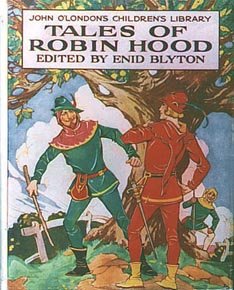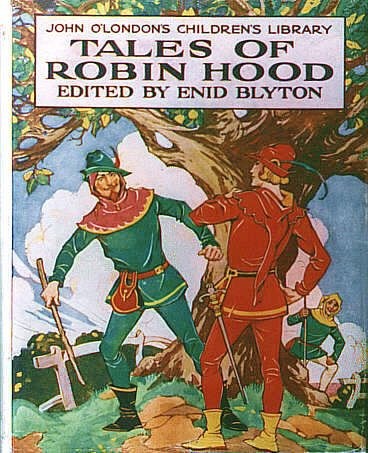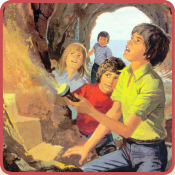
Tales of Robin Hood (Robin Hood Book)

Book Details...
First edition: 1930
Publisher: George Newnes
Illustrator: Uncredited
Category: John o'London's Children's Library
Genre: History/Mythology
Type: Short Story Series Books
Publisher: George Newnes
Illustrator: Uncredited
Category: John o'London's Children's Library
Genre: History/Mythology
Type: Short Story Series Books
On This Page...
Reprints
1. 1949 Latimer House, illustrations and cover by Joyce A. Johnson
2. 1998 Element, illustrations by Gabrielle Morton, cover by Debbie Ryder
2. 1998 Element, illustrations by Gabrielle Morton, cover by Debbie Ryder
- How Robin Hood Became an Outlaw
Story: Specially Written - How Robin Met Little John
Story: Specially Written - How Robin Hood Turned Butcher
Story: Specially Written - How Robin Hood Met Will Scarlet
Story: Specially Written - The Wedding of Allen-a-Dale
Story: Specially Written - Robin Hood and the Bishop
Story: Specially Written - How the Bishop Hunted Robin Hood
Story: Specially Written - Robin Hood and Maid Marian
Story: Specially Written - The Golden Arrow
Story: Specially Written - The Shooting-Match
Story: Specially Written - Robin Hood and the Tinker of Banbury
Story: Specially Written - How King Richard Came to the Greenwood
Story: Specially Written - The Death of Robin Hood
Story: Specially Written

Dustwrapper of the 1st edition hardback

Soft linen-covered 1st edition




Colour plates from the 1st edition by an uncredted illustrator

Wraparound dustwrapper from the 1949 reprint, illustrated by Joyce A. Johnson
Enid Blyton keeps it simple so I much prefer her version to the ones I read many years ago. The chapters are all listed in The Cave and are fairly self-explanatory with the first relating how enemies came and killed Robin's father and all his men after a fierce fight. Robin is the only survivor and as the family home has been burnt down, he runs off to live in the Greenwood as a self-declared outlaw. Why he felt inclined to rob rich men and greedy priests and give the money to the poor is not explained but maybe his father's enemies were rich and evil people. Many others come to join the lone outlaw and so Robin Hood and his Merry Men are established.
There are thirteen chapters that deal with various incidents in the famous archer's life and most people will be familiar with one or two of them at the very least. Who hasn't heard of the time Robin met an enormous hulk of a man when he was crossing a narrow bridge? Neither would give way so a fight had to take place because of the code by which they live I guess. Other memories would include a plump character in a robe who was known as Friar Tuck, Allen-a-Dale the minstrel who was useful when the outlaws felt like a singsong, Maid Marian, Will Scarlet and, of course, the evil Sheriff of Nottingham.
One chapter deals with the first time the Sheriff met Robin when the irrepressible archer disguised himself as a butcher and the incident that took place would probably have cemented the Sheriff's hatred of the outlaws.
Over the months Robin adds to his troupe such well-known people as John Little and Allen-a-Dale and he's also reunited with two friends from the days of his youth - Will Scarlet and Maid Marion. The Sheriff of Nottingham is not the outlaws' only foe because the Bishop of Hereford has no love for Robin either. One tends to think of Bishops as very good people but that presumption isn't always true although the enmity in this case could have come about because of an encounter the Bishop and his men have with Robin and Co. The pompous Bishop is forced to attend an outlaw feast under the Greenwood trees after which he is robbed and ridiculed. He plans revenge but Robin is not unlike Frederick Trotteville when it comes to disguising himself and with the help of an old dame he dresses up as a woman – a bearded one at that, and the overall result is that no one ventures near the Holy-One for two days such is his wrath at being bamboozled! Further on we learn how Middle the Tinker came to join Robin's band of outlaws
Subterfuge on both sides is employed when a great shooting match is proclaimed. The Sheriff has a plan. He has to catch Robin Hood if he wishes to keep his job and Robin has to attend the match because he much desires the magnificent golden arrow that's being offered as a prize for the winner. Could Robin claim it? There's a jolly good chance that he could because this dude is one of the finest archers around. His skill has been honed continuously since he was a youth so there's really no other person capable of topping him save perhaps, Green Arrow - who exists in the comic books!
The King of England in those times was Richard – known as Richard the Lion-Heart. Despite his chosen life style, Robin Hood is very loyal to the King and all that he stands for. Richard hears tales of the outlaw band and feels that he'd like to see what they're all about so he arrives in Nottingham to search Sherwood Forest with his nobles and his soldiers but Robin and his Merry Men are nowhere to be found. Richard is unaware that he's been spotted though because Robin has a thousand eyes to call upon and they have seen the King and every one of his men roaming the Greenwood on their fruitless search. Taking advice from the Bishop, Richard changes tactics by disguising himself and entering the Greenwood with a handful of his men dressed as monks and at last he comes face to face with the legendary archer and his followers. There is an account of what happens and how the King is entertained and then Robin and some of his men set off for London to be with Richard and the legend is made a noble peer - Robert, Earl of Huntingdon.
Robin Hood is one of the classics and not an Enid Blyton original so it has a rather sad ending that deals with a subject rare in Blyton books. The Death of Robin Hood tells us how John, Richard's corrupt brother, takes charge when the King sets off on one of his crusades.
Robin is unhappy.
He began to cast his mind back to the old days when he had been so happy in the forest with all his Merry Men. He thought of the sunshine between the trees, the singing of the birds in the early morning, the laughter of his men, and the twang of the yew bows as the arrows sped away. He longed to be back in the greenwood with all his merry company.
He returns!
Prince John is the one who's unhappy now because he's furious at being deserted. He sends his men to confront the outlaws and an enormous battle takes place. John has hundreds of soldiers at his disposal but Robin is not without help either and whenever I read of a Robin Hood battle I cannot help but recall a comment made in the film Ivanhoe. Robin and his outlaws are attacking a castle and each time the archer blows his horn, scores of men appear from out of the bushes. One of the enemy high up in the castle overlooking the forest quips –
"Another blast from that confounded horn and even the trees will come alive!"
The chapters conclude and we learn about the Prioress and what exactly happens to Robin. We are given an example of his gallantry and we also learn how the location of Robin's grave is chosen.
"Beneath this stone lies Robin Hood
No archer ever was so good
Such outlaws as he and his men
Will England never see again."
The pictures are adequate – simple and descriptive.
Enid Blyton explains the possible origin of Robin's name – the outlaws' wore suits of Lincoln Green with hoods and Robin i' the Hood was shortened to Robin Hood.
EB's ideas in the Whyteleafe books reflected a little of the Robin Hood philosophy when those in charge were allowed to rob from the rich so that everyone got a fair share of the communal swag.
I swear to honour God and the King,He wants God to help him break the eighth commandment!
To help the weak and fight the strong,
To take from the rich and give to the poor,
So God will help me with his power.
John Little is christened Little John by Robin after he joins the band. When they met on the bridge and decided to fight for the privilege of going over first John could have easily crossed it when Robin went to cut himself a staff but I suppose that wouldn't be "cricket."
Frederick Trotteville is an Enid Blyton character who's an expert in the art of disguising himself.
Sherwood Forest exists of course. It's in Nottinghamshire, England and has reduced in size since medieval times.
The outlaws were often known as Robin Hood and his Merry Men. Sounds a little dated these days.
When Robin goes to London with King Richard, the script reads: The next day Robin and his men went to London with the King but when Robin returns to Sherwood Forest we find that many of the main characters were left behind including Little John and Much the Miller's Son.
Why he was made Robert, Earl of Huntingdon and not Robin Earl of Huntingdon is not explained but the good old Internet supplied a probable answer: - Robin: Variant of Robert and in popular use as a boy's name since the medieval days of Robin Hood.
The Ivanhoe movie mentioned is the 1952 version that starred Robert Taylor.
The Cave earlier referred to, lists all the Enid Blyton books with their covers and contains a wealth of related information.








